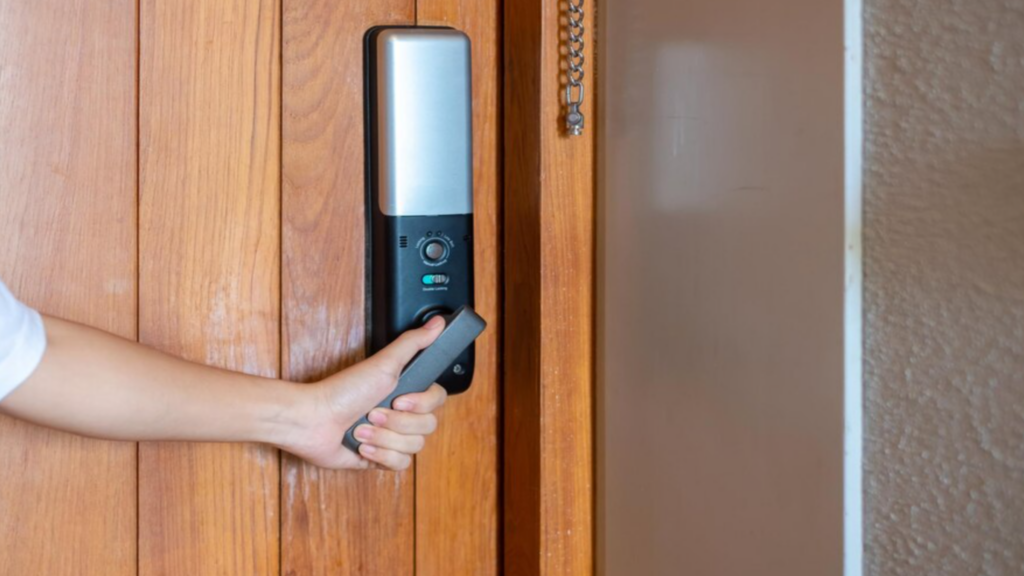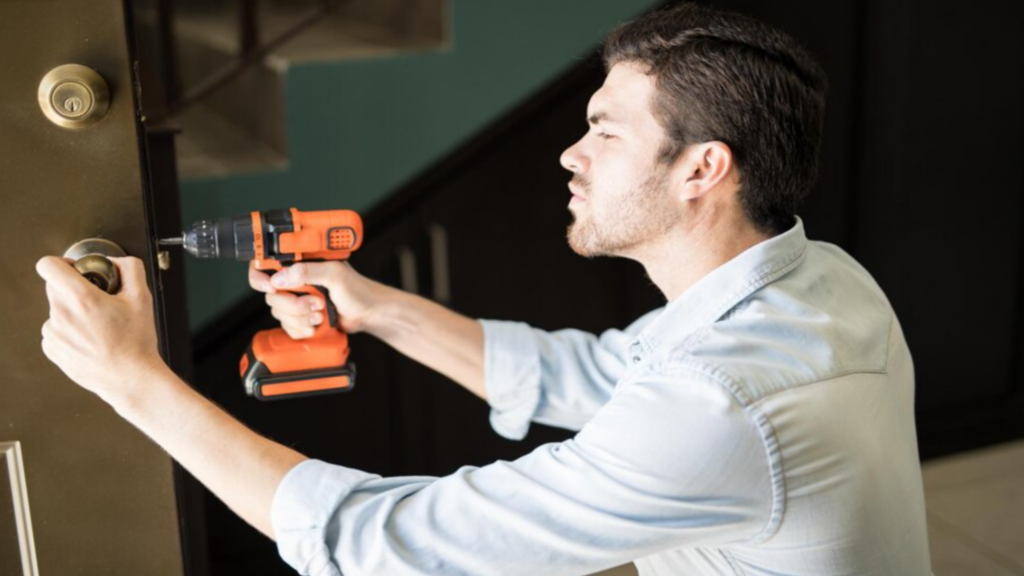Smart door locks are electronic locks that provide keyless access control with added security and connectivity features. They allow you to lock and unlock your door using your smartphone, a key fob, keypad code, or biometrics like your fingerprint. Some even have cameras and sensors to detect motion and send alerts.
The “smart” aspect comes from their ability to connect to your home Wi-Fi network and integrate with smart home platforms. This allows for convenient remote access and automation, like setting the lock to auto-lock after a certain time. Many models also utilize Bluetooth for proximity detection of phones to automatically unlock as you approach.
Smart locks aim to provide flexibility, security, and convenience that traditional keys alone cannot. Old mechanical locks are easy to copy and offer no tracking of who enters. Smart locks provide audit trails, timed access, and user permissions. With no physical key, there’s no worry about losing or copying keys.
How Smart Door Locks Work
Smart locks operate differently from traditional mechanical locks and keys. Rather than opening your door with a physical key, smart locks allow you to lock and unlock your door using your smartphone and an app.
The core components of a smart lock include the lock itself that replaces your existing deadbolt or door lock, and a bridge or connector that enables communication between the lock and your phone.
Smart locks connect to your phone using either Bluetooth or Wi-Fi. Bluetooth smart locks have a shorter range, usually 30 feet or less, allowing you to unlock your door once you’re in close proximity. Wi-Fi-enabled smart locks have unlimited range if you have an internet connection. This allows you to lock and unlock your door remotely from anywhere.

With a smart lock app on your phone, you’re able to do things like see the lock status, receive notifications when someone enters, lock or unlock the door, and grant virtual access keys. Some smart locks even allow you to set schedules and rules, like only allowing certain people access during set times.
Unlike traditional keys which can be lost, stolen or copied, smart locks provide enhanced security through virtual keys that can be issued, tracked and revoked through the app. Overall, smart locks aim to provide more convenience, flexibility and security than mechanical locks.
Benefits of Smart Door Locks
Smart locks offer several advantages over traditional keyed locks:
Increased security and access control – Smart locks allow you to control who has access to your home. You can create virtual keys to give friends or service providers temporary access without having to make copies of physical keys. You can revoke access when needed. Many smart locks also have advanced features like fingerprint scanning or facial recognition for keyless entry.
Remote locking and unlocking – With a smart lock, you can lock and unlock your doors remotely using an app on your smartphone or other device. This is convenient if you need to let in a family member when you’re not home, or if you’re unsure whether you locked the door when leaving.
Integration with other smart home devices – Many smart locks today can connect with smart home platforms and voice assistants like Amazon Alexa or Google Assistant. This allows for more automation and control. For example, you could set your smart lock to automatically unlock when you arrive home. Or lock when you use your voice assistant to run a “goodnight” scene.
Keyless entry options – Smart locks allow keyless entry through number codes, smartphones, key fobs, fingerprints, or facial recognition. This means no more fussing with physical keys. However, some people may still want to keep a physical backup key option just in case.
Smart locks make access to your home more convenient, customizable, and secure. With flexible access control and integration with other smart devices, they are useful for a range of home automation and security uses. Keyless entry options also take away the hassles of physical keys.
Key Features
Smart locks come with several handy features that make them more convenient and secure than traditional locks. Here are some of the most notable key features found in many smart lock models:
Touchscreens and Keypads
Rather than using a traditional key, many smart locks have a touchscreen or keypad. This allows you to simply enter a code to unlock the door. Some models even have a fingerprint reader built into the touchscreen for biometric unlocking.
Auto-Lock/Unlock
Smart locks can automatically lock your door after a set time period. This ensures your home is secure if you forget to lock it up. Some locks can also automatically unlock when you approach your home.
Activity Tracking Logs
Many smart locks keep a log of who has unlocked the door and when. This provides visibility into who is accessing your home.
Smartphone Integration
Most smart locks today can be controlled and monitored directly from your smartphone. This allows you to lock/unlock and view activity logs remotely.
Voice Assistant Compatibility
Leading smart lock brands have integrated with voice assistants like Amazon Alexa and Google Assistant. This allows you to lock/unlock your door using voice commands.
Installation and Setup
Installing and setting up a smart lock is relatively straightforward, but there are a few key considerations. The process will vary slightly depending on the specific model of smart lock you choose. However, most follow a similar process.

Do-It-Yourself vs Professional Installation
Many homeowners opt to install smart locks themselves to save on installation costs. With basic DIY skills and simple tools like a screwdriver, it is possible for most people to install their smart lock successfully. However, professional installation may be a better option if you are not comfortable working on your locks or doors. Professional installers have experience properly installing smart locks and can ensure it is done correctly.
Installing a Smart Lock
The basic installation process is:
1. Remove your existing deadbolt or handle set. This usually just requires unscrewing a couple screws.
2. Carefully read the installation instructions that come with your smart lock. Pay close attention to measurements to ensure proper alignment and clearance.
3. Attach the mounting plate or adapter plate (if needed) using the included screws. Make sure it is centered and level.
4. Attach the smart lock onto the mounting plate, again ensuring proper alignment.
5. Secure using the included screws, then test locking and unlocking the door to confirm smooth operation.
6. Install the strike plate onto the door frame, aligning it with the latch bolt.
7. Attach the cover plate, tighten any remaining screws, and install batteries.
Connecting and Setting Up
After installing the smart lock, you will need to connect it to your smartphone and Wi-Fi network. The app provided by the manufacturer will walk you through the setup process of connecting the lock, creating user codes, and configuring settings. Some key steps include:
- Create your user account in the app
- Connect the smart lock to your Wi-Fi network
- Add users and assign access codes or cards
- Install optional accessories like door sensors
- Test locking/unlocking using smartphone and codes
- Explore app features and settings
With those basics covered, your new smart lock will be installed, connected, and ready to use! Most smart lock setup processes are designed to be user-friendly, but if you get stuck, support resources from the manufacturer are available.
The Future of Smart Locks
Smart locks are constantly evolving as technology advances. Here are some predictions for where this technology is heading:
- Voice control – As virtual assistants like Alexa and Google Assistant become more prevalent, we can expect voice control capabilities for smart locks. This will allow for keyless and hands-free operation by just using your voice.
- Facial recognition – Some smart locks are already starting to incorporate facial recognition technology. This allows the lock to identify authorized people and unlock automatically when it recognizes you. As the accuracy of facial recognition improves, we can expect wider adoption of this feature.
- Improved biometrics – Along with facial recognition, newer forms of biometric authentication will emerge for smart locks. Options like iris scanning, finger/palm vein recognition, and gait analysis while walking could be integrated with smart locks for advanced multi-factor security.
- Longer battery life – Battery technology continues to improve, so smart locks will be able to operate longer between charges or battery replacements. Some may incorporate solar panels or kinetics for self-charging capabilities.
- Interoperability and automation – With the rise of smart home tech, smart locks will become increasingly integrated and automated. You may be able to set scenes or schedules to automatically unlock doors when certain conditions are met. Compatibility with other devices and systems will continue improving too.
- Stronger encryption – As hackers become more sophisticated, encryption methods will evolve to stay ahead of potential security threats. Expect stronger encryption standards for communication between the smart lock and your smartphone/network.
- Additional sensors – Smart locks may incorporate sensors other than just touch or motion, like temperature, humidity, ambient light, air quality, noise, etc. This data could trigger automatic locking, notifications, or integration with other smart home devices.
The possibilities are vast when it comes to the future of smart lock technology. As convenience, security, and connectivity continue to improve, smart locks will become even more capable and useful in both residential and commercial settings. The key is finding the right balance between features, functionality, and usability as the technology progresses.
Upgrade to A smart Door Lock Today!
Smart locks offer many exciting benefits compared to traditional keyed locks. By letting you control and monitor access to your home remotely via an app, they provide convenience, security, and peace of mind. No more fumbling for keys or worrying about lost keys falling into the wrong hands.
Smart locks are ideal for busy families, people who travel frequently, Airbnb hosts, and anyone looking to enhance home security and automation. With features like auto-unlock, guest codes, and activity notifications, you remain in control of your home no matter where you are.
Looking ahead, smart home technology will only continue improving. As smart locks get sleeker, more advanced, and even more seamless to use, they stand to fully replace old-fashioned locks one day. For now, they let us get a taste of the convenient future in our homes today. For more information on the latest smart door lock technologies, contact one of our expert energy advisors and they will be able to help you decide the best lock for your home.


No Comments